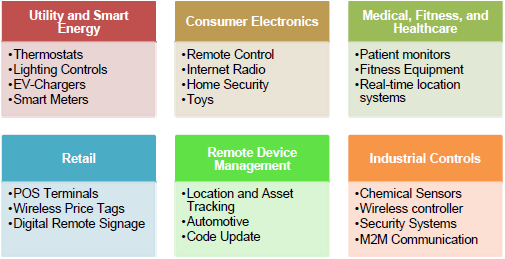


Wi-Fi technology is expanding beyond its traditional borders into everything from consumer electronics to medical devices and industrial controls as well as the growing movement toward the Internet of Things (IoT). This means that more and more engineers working on embedded electronics are being asked to design for interoperability with other products that are also using Wi-Fi. Such designs must comply with at least one of the IEEE 802.11 standards, which requires a hands-on testing program. There is a lot to consider, especially for someone new to RF product integration, and it can be hard to know where to begin.
In this post I’ll first go over some of the basics of WLAN integration and 802.11, discuss typical applications and then look at some parametric filters (a fancy way of saying key considerations) for your module search, module tradeoffs, and whether RF engineers are needed. Wi-Fi module selection is one of about eight parts of a larger discussion about adding Wi-Fi to a design. Choosing the right module is the perfect place to start because it is so critical to your design.
Typical applications using Wi-Fi Modules
In this context, think of Wi-Fi as a way to achieve interoperability with other WLAN devices. WLAN refers to devices that comply with one or more of the IEEE 802.11 standards and may be used in a variety of scientific, industrial, commercial and consumer applications and shown below Many devices can use Wi-Fi, and these devices can all connect to a network resource via a wireless network access point.

Filters for your module search
Module makers usually categorize modules by parameters. Use these parameters to refine your search based on your application specifications. This is a long list and we encourage you to download the Selecting a Wi-Fi Module application note to get specifics on each parameter:
- Protocol / standard supported
- Operating frequency band
- Transmit range
- Transmit power output, operating supply current or voltage
- Data rate (max throughput)
- Microcontroller/microprocessor
- Operating system (driver support)
- Antenna and connector
- Secure Wi-Fi authentication schemes
- Shape and size
- Operating temperature range
- Packaging type
- PCB layout
- Hardware interfaces
- Other features (real-time clock, auto-sleep / wake-up, etc.)
- Certification/compliance
Remember that you need to consider both hardware and software because a Wi-Fi module is a functional unit that can only run while embedded in the system. It is also worth noting that the Wi-Fi software should include a device driver, an integrated IEEE 802.11 security supplicant, and a full-featured management and monitoring utility. The hardware of a Wi-Fi module contains two main parts: a Wi-Fi chip and an application host processor.
Tradeoffs
Like anything, there are trade-offs when making a Wi-Fi module selection. The three key factors in your evaluation are data rate, range and power requirements. When you compare different Wi-Fi protocols, IEEE 802.11n and IEEE 802.11ac have the advantage of the higher data throughput, while IEEE 802.11b/g has the advantage in compatibility and power requirements.
IEEE 802.11n provides operational advantages of higher data throughput, greater range and robust link quality, and enables greater network utilization. 802.11ac builds on high bandwidths over extended ranges by offering 2x the bandwidth for the 600 Mbps via 802.11n. It enables Wi-Fi solutions to meet today’s demand for high capacity and high quality mobile real-time applications like video and voice. Using multiple antennas (MIMO technology) further increases the data rate and the range. These extended features, however come at a price through the use of multiple antenna structures, increased BOM design complexity, and the use of more power.

Typical tradeoffs when selecting a Wi‐Fi module
RF engineers and Wi-Fi modules
I have been discussing the purchase of a pre-made Wi-Fi module which implies that an RF engineer isn’t needed. Most manufacturers don’t have the RF expertise required to build network devices. However, there are tasks, like troubleshooting and building custom embedded modules for manufacturing require some RF expertise. In these cases, you may need to hire an RF consultant or rely on the expertise of a WLAN and RF test equipment manufacturer.
Selecting the Wi-Fi module that will best fit your design application starts with carefully considering which Wi-Fi module parameters will address your needs, what tradeoffs you’ll be making with your choice, and what WLAN and RF device test equipment you are going to use. Download the How to Select a Wi-Fi Module application note for a more detailed look at this technology and how to make it work best for your needs.


